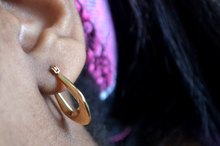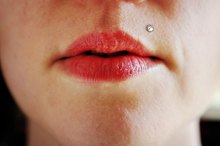Why Are My Pierced Ears Sore?
Soreness, irritation and discomfort can occur with newly pierced ears or established ear piercings. Infection is the most serious concern, but there are other possible causes.
Possible noninfectious causes include a reaction to ear jewelry, traumatic injury and excess weight on your ears. See your doctor to determine the cause of your ear soreness, as early diagnosis and treatment are important if an infection occurs.
Initial Soreness
An ear piercing is essentially a puncture wound, which causes initial pain and soreness.
Pain associated with the piercing itself is typically greater with an ear cartilage piercing than with an earlobe piercing. Use of a spring-loaded piercing gun -- which should not be used for piercings involving ear cartilage -- may be more painful than piercing with a needle. Soreness associated with a new ear piercing typically progressively decreases during the first few days of the healing period.
- An ear piercing is essentially a puncture wound, which causes initial pain and soreness.
- Pain associated with the piercing itself is typically greater with an ear cartilage piercing than with an earlobe piercing.
Soreness During the Healing Period
Sore on Tip of Ear Won't Heal
Learn More
**Ear piercing incites an inflammatory reaction that typically involves a small amount of swelling, redness and soreness during the initial days of the healing period.
Earlobe piercings typically heal completely within 4 to 6 weeks. However, ear cartilage piercings -- such as a tragus, conch or helix piercing -- do not heal fully for 3 to 6 months. ** Swelling and redness usually resolve fairly quickly, typically within about a week. Mild discomfort after this period usually occurs only when the piercing is touched or moved, such as when you're cleaning the area or rotating the ear jewelry.
- Ear piercing incites an inflammatory reaction that typically involves a small amount of swelling, redness and soreness during the initial days of the healing period.
- However, ear cartilage piercings -- such as a tragus, conch or helix piercing -- do not heal fully for 3 to 6 months.
Infection
Infection is the most common medical problem associated with a recent ear piercing.
Infection can occur due to use of unsterile piercing equipment, not following aftercare instructions for keeping the area clean, or touching the piercing with dirty hands.
However, even when everything is done properly, a bacterial infection can still occur due to contamination of the new piercing by bacteria normally present on your skin.
Infections more commonly occur with ear cartilage piercings than with standard earlobe piercings. Signs and symptoms of an infection in an ear piercing include: -- new, persistent or increasing redness, pain or swelling -- spreading redness or swelling around the piercing -- thick, opaque drainage from the site
While thin, watery drainage from a new piercing frequently occurs during the initial few days after an ear piercing, drainage of pus typically indicates a bacterial infection. Pus is characteristically thick, often has a foul odor, and usually appears yellowish or greenish in color. Seek immediate medical care if you suspect your ear might be infected, especially if you develop a fever or chills.
- Infection is the most common medical problem associated with a recent ear piercing.
- Infection can occur due to use of unsterile piercing equipment, not following aftercare instructions for keeping the area clean, or touching the piercing with dirty hands.
Earring Choices and Wearing Patterns
Alternatives to Pierced Ears
Learn More
Your earring choices might be to blame if your pierced ears are sore. For example, you may experience a pinching sensation if the post is too short for your ear thickness. Screwing the back on too tightly with threaded-post earrings can cause similar discomfort.
Heavy earrings might look great but can pull on your ears and cause discomfort. Large earrings that accidentally catch on your clothing or hair can cause tearing of your piercing with associated soreness until the injury heals.
If you haven't worn earrings in for a while, you may find that even well-established, fully-healed piercings can be a bit sore when you put earrings in. This commonly occurs due to slight shrinkage of the holes during the time when you weren't wearing earrings. Never force an earring into a piercing if it doesn't slide in easily.
- Your earring choices might be to blame if your pierced ears are sore.
- If you haven't worn earrings in for a while, you may find that even well-established, fully-healed piercings can be a bit sore when you put earrings in.
Earring Material
Soreness of your ear piercings might reflect an allergic reaction or sensitivity to your ear jewelry. Jewelry made from surgical steel, titanium, niobium and platinum are the safest materials to place in your ear piercings, according to the Association of Professional Piercers 4. White or yellow gold jewelry that is at least 14 karats and nickel-free is also well tolerated by most people. It's especially important to wear high-quality earrings made of metals that are unlikely to cause irritation when your piercings are healing.
Approximately 18 percent of people in North American are allergic to nickel, according to the American Academy of Dermatology 2. This metal is commonly used in less expensive earrings, including gold-plated and gold-filled pieces.
Nickel can lead to allergic contact dermatitis in people who are sensitive to the metal, although it may take some time for symptoms to develop. Common signs and symptoms include: -- an itchy, red rash -- burning or stinging -- redness and swelling
- Soreness of your ear piercings might reflect an allergic reaction or sensitivity to your ear jewelry.
- Jewelry made from surgical steel, titanium, niobium and platinum are the safest materials to place in your ear piercings, according to the Association of Professional Piercers 4.
Warnings and Precautions
Ear piercings can be a fun way to express your individuality and style. However, soreness or other signs of inflammation should not be ignored, as they are your body's way of telling you something is wrong. Most infections related to ear piercing occur during the first month. Seek medical evaluation right away if you experience new, persistent or worsening pain associated with a recent ear piercing, especially if accompanied by redness, swelling or drainage of pus. In most cases, the piercing can be saved with early treatment.
A delay in treatment, however, can potentially lead to a serious infection and permanent deformity of your ear.
This is particularly applicable to piercings involving the ear cartilage, which tends to develop more serious and resistant infections compared to the earlobes. Seek emergency medical care if you develop a fever or chills, or notice expanding redness or red streaks radiating from your piercing.
Reviewed and revised by: Tina M. St. John, M.D.
- Ear piercings can be a fun way to express your individuality and style.
- However, soreness or other signs of inflammation should not be ignored, as they are your body's way of telling you something is wrong.
Related Articles
References
- Western Journal of Medicine: Common Complications of Body Piercing
- American Academy of Dermatology: Nickel Allergy: How to Avoid Exposure and Reduce Symptoms
- Boston Children's Hospital Young Men's Health: Body Piercing
- Dermatologic Complications with Body Art; Christa de Cuyper and Maria-Luisa Perez-Cotapos
- Greenberg's Text-Atlas of Emergency Medicine; Michael I. Greenberg, et al.
- American Family Physician: Complications of Body Piercing
- Gabriel OT, Anthony OO, Paul EA, Ayodele SO. Trends and complications of ear piercing among selected Nigerian population. J Family Med Prim Care. 2017;6(3):517–521. doi:10.4103/2249-4863.222045
- Uter W, Werfel T, White IR, Johansen JD. Contact allergy: A review of current problems from a clinical perspective. Int J Environ Res Public Health. 2018;15(6):1108. doi:10.3390/ijerph15061108
- Park JK, Kim KS, Kim SH, Choi J, Yang JY. Reconstruction of a traumatic cleft earlobe using a combination of the inverted V-shaped excision technique and vertical mattress suture method. Arch Craniofac Surg. 2017;18(4):277-281. doi:10.7181/acfs.2017.18.4.277
Writer Bio
Maude Coffey retired after 10 years working as a professional body modification artist in the tattoo industry. She is certified in principles of infection control and blood-borne pathogens. Coffey received additional training and classes, such as anatomy, jewelry standards and aftercare, from the Association of Professional Piercers. Coffey aims to educate about safe tattooing and piercing practices while writing for various websites.









